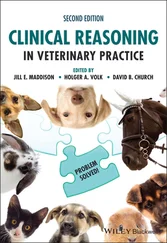Clive Elwood - Leadership in Veterinary Medicine
Здесь есть возможность читать онлайн «Clive Elwood - Leadership in Veterinary Medicine» — ознакомительный отрывок электронной книги совершенно бесплатно, а после прочтения отрывка купить полную версию. В некоторых случаях можно слушать аудио, скачать через торрент в формате fb2 и присутствует краткое содержание. Жанр: unrecognised, на английском языке. Описание произведения, (предисловие) а так же отзывы посетителей доступны на портале библиотеки ЛибКат.
- Название:Leadership in Veterinary Medicine
- Автор:
- Жанр:
- Год:неизвестен
- ISBN:нет данных
- Рейтинг книги:4 / 5. Голосов: 1
-
Избранное:Добавить в избранное
- Отзывы:
-
Ваша оценка:
- 80
- 1
- 2
- 3
- 4
- 5
Leadership in Veterinary Medicine: краткое содержание, описание и аннотация
Предлагаем к чтению аннотацию, описание, краткое содержание или предисловие (зависит от того, что написал сам автор книги «Leadership in Veterinary Medicine»). Если вы не нашли необходимую информацию о книге — напишите в комментариях, мы постараемся отыскать её.
Leadership in Veterinary Medicine
Leadership in Veterinary Medicine
Leadership in Veterinary Medicine — читать онлайн ознакомительный отрывок
Ниже представлен текст книги, разбитый по страницам. Система сохранения места последней прочитанной страницы, позволяет с удобством читать онлайн бесплатно книгу «Leadership in Veterinary Medicine», без необходимости каждый раз заново искать на чём Вы остановились. Поставьте закладку, и сможете в любой момент перейти на страницу, на которой закончили чтение.
Интервал:
Закладка:
Table of Contents
1 Cover
2 Title Page
3 Copyright Page
4 Dedication Page
5 Acknowledgements
6 Foreword
7 Part I: Foundations of Veterinary Leadership 1 Introduction1.1 What Is Leadership, and Why Do We Need a Book on Veterinary Leadership? 1.2 My Leadership Experiences 1.3 My Approach 1.4 Who Is the Book for? 1.5 How to Use This Book 1.6 What Is ‘Good Enough’? Questions Further Reading References 2 Veterinary Leadership in Context 2.1 Introduction 2.2 Complex Systems and Wicked Problems 2.3 What Is a Profession? 2.4 The History of the Veterinary Profession 2.5 What Are the Veterinary Professions, and What Are They for? 2.6 Uncertainties of Role and Identity 2.7 Professional Archetypes 2.8 Why Is Leadership Important in the Veterinary Professions? 2.9 Veterinary Teams 2.10 What Difference Does Leadership Make? 2.11 The Discipline of ‘Leadership’ in Veterinary Medicine 2.12 The Future of Leadership in Veterinary Medicine 2.13 Conclusion Questions Further Reading References 3 Leadership Repertoires 3.1 Introduction 3.2 Cognitive Competencies 3.3 Emotional Competencies 3.4 Intuition 3.5 Conclusion Questions Further Reading References 4 Self‐Leadership 4.1 Introduction 4.2 Self‐Awareness 4.3 How Do Others See Your Leadership? 4.4 How Do you Want Others to See Your Leadership? 4.5 Self‐Motivation 4.6 Self‐Regulation 4.7 Leadership Traps and Shadows 4.8 Self‐Development 4.9 Self‐Care 4.10 Conclusion Questions Further Reading References 5 Veterinary Professionals and Leadership 5.1 Are Veterinary Professionals Different? 5.2 The Leadership–Followership Dynamic 5.3 What Do Veterinary Professionals Want from Leadership? 5.4 It's Not Just the Veterinary Professionals 5.5 Conclusion Questions Further Reading References 6 Analysing Organisations 6.1 Introduction 6.2 Why Do Organisations Differ? 6.3 How Organisations Differ 6.4 Analysing Organisations 6.5 How Do Organisations Develop? 6.6 Leadership and the Organisational Context 6.7 Conclusion Questions Further Reading References 7 Understanding Strategy 7.1 Introduction 7.2 Strategy Now 7.3 Strategy Then? 7.4 Strategy How? 7.5 Conclusion Questions Further Reading References 8 Communicating and Engaging 8.1 Introduction 8.2 How Do We Communicate? 8.3 What You Want to Say Is Not (Necessarily) What I Hear 8.4 Types of Communication 8.5 If You Want to Be Heard, First Listen 8.6 Asking Great Questions 8.7 Think About Your Intended Audience 8.8 What Message Is Received? 8.9 Putting It Together 8.10 Engagement and Authenticity 8.11 What If They Don't Want to Listen? 8.12 Negotiation 8.13 Conflict and Conflict Management Styles 8.14 Mediation 8.15 Difficult Conversations 8.16 Conclusion Questions Further Reading References 9 Creating Effective Teams 9.1 Introduction 9.2 Who Is the Team? 9.3 What Is the Shared Purpose? 9.4 Shared Leadership 9.5 Relational Team Leadership 9.6 Creating the Right Team Environment 9.7 Task Leadership 9.8 If, and When, to Intervene 9.9 Team Maintenance 9.10 When Teams End 9.11 Conclusion Questions Further Reading References 10 Leadership and Change 10.1 What Is Change? 10.2 Systemic Perspectives on Change 10.3 Psychological Aspects of Change 10.4 Change Leadership 10.5 Adoption and Diffusion of Change 10.6 Conclusion Questions Further Reading References 11 Remote and Virtual Leadership 11.1 Introduction 11.2 Definitions 11.3 Considerations for Remote Leadership 11.4 Remote Leadership Tasks 11.5 Considerations for Virtual Leadership 11.6 Virtual Leadership Tasks 11.7 Informal Virtual Leadership 11.8 Hybrid Models 11.9 Conclusion Questions Further Reading References 12 Leadership and Development 12.1 Introduction 12.2 What Are You Developing? 12.3 Does Leadership Development Work? 12.4 Engagement and Motivation to Develop Leadership 12.5 Developing a Leadership Identity 12.6 Kolb Experiential Learning Cycle 12.7 Creating a Feedback Culture 12.8 Choices for Leadership Development 12.9 Succession Planning 12.10 Conclusion Questions Further Reading References 13 Leadership in Practise 13.1 Introduction 13.2 Choose Your Behaviours 13.3 Be Brave and Authentic 13.4 Be Decisive and Assertive 13.5 Be Honest, Fair, and Transparent 13.6 Have Integrity and Trustworthiness 13.7 Own Your Failures 13.8 Be Grateful and Positive 13.9 Understand the Organisation 13.10 Get to Know the People 13.11 Think of the Group 13.12 Align and Create Direction 13.13 Trust 13.14 Empower 13.15 Nurture 13.16 Protect 13.17 Be Tough on Standards and Kind to People 13.18 Connect 13.19 Make Time 13.20 Follow 13.21 Accept Messiness and Dance with Complexity 13.22 Conclusion Questions Further Reading References
8 Part II: Veterinary Leadership Scenarios Scenario 1 A Thief in the House? Scenario 2 A Failed Strategy? Scenario 3 ‘What Do You Think You Are Doing?’ Scenario 4 At Last, a Proper Lunch Break! Scenario 5 Not a Trivial Matter Scenario 6 Convincing the Board Scenario 7 A Tough First Time Scenario 8 A New Broom? Scenario 9 A Bit of a Beef Scenario 10 Into the Lion's Den Scenario 11 Our Planet Is at Stake! Scenario 12 Creating a New Future Scenario 13 On the Horns of a Dilemma
9 Appendix A Behavioural Drivers Questionnaire
10 Index
11 End User License Agreement
List of Tables
1 Chapter 1 Table 1.1 The essence of leadership.
2 Chapter 2 Table 2.1 Eight possible archetypes of veterinary professionalism and their...
3 Chapter 4 Table 4.1 Resources for testing aspects of you and your leadership. In all ...Table 4.2 Some of the traps and unhelpful behaviours we can fall into in le...
4 Chapter 5Table 5.1 Human needs range from basic physiologic to existential self‐actu...Table 5.2 Profiles of motivation needs in professional work.Table 5.3 Behavioural drivers, their strengths, weaknesses, associated fear...
5 Chapter 6Table 6.1 Organisational differences according to segmentation of professio...Table 6.2 Organisations as points on a spectrum that reflect stages of huma...Table 6.3 The nine dimensions of culture that GLOBE researchers used to cha...Table 6.4 Phases of organisational (corporate) growth.
6 Chapter 7Table 7.1 How animals help fulfil human needs.Table 7.2 Questions to help explore strategy for professional practice. At ...Table 7.3 Elements of a ‘people’ strategy to for veterinary professional se...
7 Chapter 8Table 8.1 Question types and examples used in Socratic questioning to deepe...Table 8.2 Different types of communication, appropriate situations, and the...Table 8.3 Different communication media and their suitability for different...Table 8.4 Language and attitudes to reframe and mediate from conflict to so...
8 Chapter 9Table 9.1 Behavioural indicators of a psychologically unsafe team; a lack o...
9 Chapter 10Table 10.1 Examples of nondivergent and divergent changes in different vete...Table 10.2 Change leverage points in a complex responsive system.Table 10.3 The Cynefin decision‐making framework applied to leadership in v...Table 10.4 Influences on the adoption and diffusion of change in healthcare...
10 Chapter 11Table 11.1 A digital repertoire for virtual leadership.Table 11.2 What you might attend to when monitoring virtual teams.
11 Chapter 12Table 12.1 Examples of both positively and negatively construed motivations...Table 12.2 A framework for delivery of formative feedback in the moment. In...Table 12.3 An approximate cost benefit analysis of leadership development i...
List of Illustrations
1 Chapter 2 Figure 2.1 The veterinary sector sits within and in relation to society; it ...
2 Chapter 3 Figure 3.1 Components of leadership repertoire. Cognitive, emotional, and in...
3 Chapter 4 Figure 4.1 The ladder of inference. Our habitual and unconscious ways of sel... Figure 4.2 The Johari window gives structure to understand and explore the r... Figure 4.3 Where is the sweet spot for your leadership, where your authentic...Figure 4.4 Time management budgeting for veterinary professionals. What perc...
Читать дальшеИнтервал:
Закладка:
Похожие книги на «Leadership in Veterinary Medicine»
Представляем Вашему вниманию похожие книги на «Leadership in Veterinary Medicine» списком для выбора. Мы отобрали схожую по названию и смыслу литературу в надежде предоставить читателям больше вариантов отыскать новые, интересные, ещё непрочитанные произведения.
Обсуждение, отзывы о книге «Leadership in Veterinary Medicine» и просто собственные мнения читателей. Оставьте ваши комментарии, напишите, что Вы думаете о произведении, его смысле или главных героях. Укажите что конкретно понравилось, а что нет, и почему Вы так считаете.












